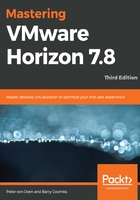
Dynamic networking capabilities
To manage the use of bandwidth, PCoIP employs adaptive encoders that automatically adjust the image quality on networks that are congested. The level of network congestion can be defined via policies that allow you to configure this based on use case, location, and so on. So, maybe the limits are different for those users based in the HQ on the main network, versus those in satellite/branch sites. When the network is no longer congested, then the maximum image quality is restored. PCoIP doesn't transfer any user data over the network. It just transmits pixels, and therefore uses a real-time User Datagram Protocol (UDP), rather than using a TCP protocol (used for Voice over IP (VoIP), to ensure a responsive and interactive end user experience. This will reduce the overall bandwidth requirement and deliver the best interactive user experience, based on the network bandwidth available at any particular time.
UDP does not employ error checking or correction, and therefore removes any overheads in processing the checking and correcting. The lack of retransmission delays that you would find with a TCP protocol means that it's ideal for streaming media. For the end user experience, these delays translate to jerky movements, most commonly experienced when watching video content.